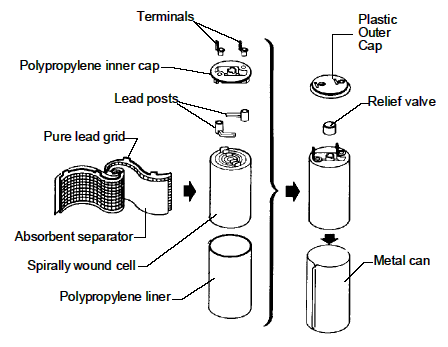Sealed Lead Acid Battery
Battery Application & Technology
These types of batteries confine the electrolyte, but have a vent or valve to allow gases to escape if internal pressure exceeds a certain threshold. During charging, a lead-acid battery generates oxygen gas at the positive electrode.
Sealed lead-acid batteries are designed so that the oxygen generated during charging is captured and recombined in the battery. This is called an oxygen recombination cycle and works well as long as the charge rate is not too high. Too high of a rate of charge may result in case rupture, thermal runaway, or internal mechanical damage.
The valve-regulated battery is the most common type of sealed battery. It was developed for stationary and telecommunication battery applications. These types of sealed batteries have a spring-controlled valve that vents gases at a predetermined pressure. Typical pressure thresholds are from 2 to 5 psig, depending on the battery design. Although the term "valve regulated" is often used synonymously to describe sealed lead-acid batteries, not all sealed batteries are valve-regulated. Some battery designs employ replaceable vent plugs or other mechanisms to relieve excess pressure. Sealed batteries were developed to reduce the maintenance required for batteries in active service. Since electrolyte levels are preserved by trapping and recombining off-gasses, there should not be any need to add distilled water over the life of the battery. These batteries are often misnamed "maintenance free." In fact, all maintenance practices applicable to unsealed type batteries are applicable to sealed type batteries. The only exception is that electrolyte levels cannot, and should not need to be, maintained.
Sealed type batteries are often avoided for backup power source applications for several reasons. One reason is that the state of charge of sealed type batteries cannot be ascertained by the usual specific gravity measurement. Reliable alternative methods to measure the state of charge for sealed type batteries are under development. A second reason is their sensitivity to high temperatures.
Typical Cylindrical Sealed Lead Acid Battery
